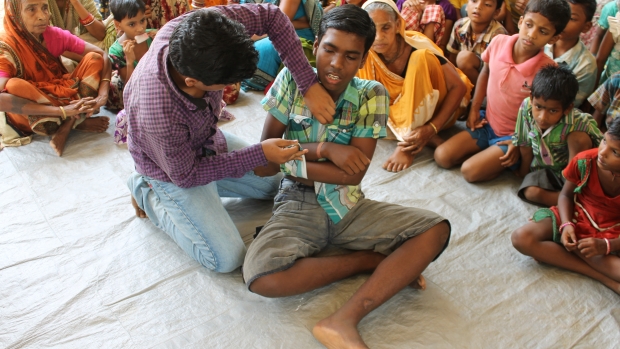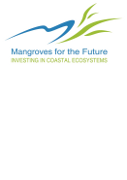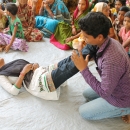Grants :: Small Grant Facilities :: Strengthened capacity of children, communities and local government by better preparedness and mitigation of climate change and disaster risk in Kendrapara district, Odisha
Strengthened capacity of children, communities and local government by better preparedness and mitigation of climate change and disaster risk in Kendrapara district, Odisha

Children demonstrate basic first aid techniques for use in d ... , Hasina Village, Kendrapara, Odisha © MFF India, 2014
Objectives
The objective of the project was to strengthen and sustain community stewardship in conservation, restoration, sustainable management of mangroves based on scientific principles, taking into account the vulnerability of the region to natural disasters, sustainable livelihood security for local communities and conservation of ecologically significant natural resources.
Background
Kendrapara district situated in a tropical sub-climate area on the eastern coastline of India faces Bay of Bengal on the sea level. The district slopes down to Bay of Bengal from 7.5 meters. It’s densely populated coastal plains have alluvial deposits from its river systems. It is fertile yet highly erosive. In last 4-5 decades, banks have been eroded by the rivers as well as the sea. This has led to mass displacement amongst inhabitants. Three villages were completely submerged and four villages partially submerged by River Brahmani in Chandibaunsamula GP before the project intervention. The coast line along Bay of Bengal in Satavaya and Pentha has shifted 3-5 kms in-land, making the coastal settlements extremely vulnerable to disasters. In the district, the temperature varies between 15–40°C throughout the year, with an average yearly rainfall of 2033mm (District Disaster Management Plan).
The Gram Panchayats (GP) of Chandibaunsamula and Kandira in Kendrapara district are highly vulnerable and prone to disasters. Chandibaunsamula GP is 7-8 kilometres from sea by aerial distance and is situated on the bank of River Brahmani at the merging point of River Brahmani and River Kharasrota. River bank erosion has caused the disappearance of 4 villages in 40 years with two more which are at the verge of extinction. High river bank erosion and annual floods is a common feature of the Gram Panchayat. The project villages of Chandibaunsamula GP were covered by child centered community based disaster risk reduction (CCCBDRR) project with the objective of building resilience among children and communities towards future disasters. On the contrary to Chandibaunsamula GP, villages of Kandira GP covered under this project never had that kind of intervention. The project design was intended to supplement CCCBDRR project and collectively increase resilience of the children and communities in the project intervention area towards disasters and climate change risks.
Target beneficiaries
Children and communities from villages in Rajnagar, Kendrapara, Orissa
Outputs
The key deliverables of this project are:
- 6 ha of mangroves land replanted with 25,000 saplings
- Women Self Help Groups led mangroves nursery will be developed to raise 60,000 saplings
- 1000 human-days labour will be created through this project
- Active engagement of the local Community and key stakeholders (local governance and government) in mangroves replantation, protection and monitoring
- DRR plans for 6 of the villages
Accomplishments and challenges
- Increased Awareness: Orientation were done at cluster level bringing different communities together. Intra community and intercommunity relationship got strengthened due to this. Protection of mangrove plantation sites also strengthened due to improved relationship for example between Nuagaon and Balarampur. Through our intervention there has been a noticeable change among communities towards their awareness level on the importance of Mangroves and their active participation in the plantation/ replantation of mangroves
- Engaging participation and learning exposure for 1140 children, women and men through rallies, drawing competitions, debates and visits to mangrove forests
- Improved rapport and strengthened relationship among multiple stakeholders- project staff, forest department, gram panchayats, the women self-help groups (SHG’s) and community.
- Increased participation among children in the school and village level activities. Programs like Van Mahotsav is an annual tree-planting festival in India, celebrated in the first week of July. This movement was initiated in the year 1950 by India's then Union Minister for Agriculture, Kulapati Dr. K M Munshi. It has gained immense national importance and every year, millions of saplings are planted all across India in observation of the Van Mahotsav week and visits by experts and dignitaries further contributed to the cause.
- The project with support from MFF-IUCN has Strengthened Community Capacity and Ownership with requires skillsets and capacities at the village/ gram level on land preparation, mangrove plantation and nursery development. Capacity building also developed a perspective towards mangroves and mangroves as a part of micro-ecosystem. Though the real impact or result will take a decade to manifest but a vision is developed among the community members
- Partner NGO was felicitated with PRAKURTI MITRA award by Government of Odisha. This is a sub-district level award given by Ministry of Environment. And Forest, Govt. of Odisha to institutions/ organizations for their contribution to local aforestation and protection. This year 2015, Save the Children’s local partner Nature’s Club partly supported by MFF, through this project was given the award contributing to the selection criteria for the intervention.
- Panchayati Raj Institution (PRI) forms a part of the local self-governance. Bodies in India. It is a, 3 tier system from Panchayat to Zilla parisad.PRI have shown their interest to provide free land for mangrove replantation in the barren land within Gram Panchayat.
- The Forest Department is committed to support future replantation of mangroves in the Bhitarkanika sanctuary. However, they are looking for support from external players in regeneration efforts; they were particularly happy that the community had provided private land.
Contributions to cross-cutting themes
The communities in Rajnagar district face flooding and natural disaster events on a frequent basis; the resultant salinity ingress is a significant threat. As the community is largely agricultural dependent, this imperils their income and food security. The mangrove plantations are predominantly located between the river and the agricultural fields, and are a natural barrier to flooding and storm related events. As such they constitute a nature-based solution to the imminent threat of the impacts of climate change. In recognition of this, and through efforts made through this project, the regeneration/plantation of mangroves has been included in the action plan against climate change by the Gram Panchyat, through the Gram Sabha.
Lessons Learned
- At the beginning of the project local communities had critical views about forest department and they were not at all ready for mangrove plantation and to take help of forest officials. There was a clear communication gap between them. This project helped in reducing tension and creating mutual faith among them. As narrated in the case story community and Forest department witnessed larger conflicts and did not meet eye to eye. Some activities and in particular the Mangrove plantation is a key activity through which we have promoted interaction and rapport between the community and Forest officials. Regular interaction through visits and capacity building programs has helped strengthen the relation.
- This project running for 18 months and having no exit thought process makes the initiative vulnerable due to short time and closure of the project makes the institutions, communities and children especially, will erode their faith in mobilisation process. The plantations are young so also the nursery (less than one yr.) and need few months longer support to strengthen the initiative. There is still a need for resources to support the nursery and continue the intervention to its sustainable end.
- Children are the most active and committed participants. The Sustainability of the initiative in the longer run- With children being participants, taught on the need/ benefits of Mangroves- they are more inclined to act as change agents for its protection and conservation. They will also see many of the seedlings/ plants that are planted and grow with the Mangroves.
Project Facts
Country
Location
7 villages in Chandilbaunsamula Gram Panchayat and 4 villages in Kandira Gram Panchayat, Rajnagar Block, Kendrapara district, Odisha
Topic
- Capacity Building
- Civil Society Engagement
- Integrated Coastal Planning
- Knowledge management and communications
Duration
10th Dec 2013 to 10th Jun 2015
MFF Grant Amount
INR 1,160,000
Co-financing Partner
Save the Children: INR 118,000
Implementing Partner
Ms. Jyothi Sharma
National Manager – Institutional Partnerships, Resource Mobilization
Save the Children, India
Email: j.sharma@savethechildren.in
Related Images
Related Publications

Strengthened capacity of children, communities and local government by better preparedness and mitigation of climate change and disaster risks in Kendrapara District, Odisha
Author: Save the Childre and IUCN
Publisher: IUCN
Posted on: 12th May 2016
Category: SGF (Small Grant Facility)
Size: 318 KB

